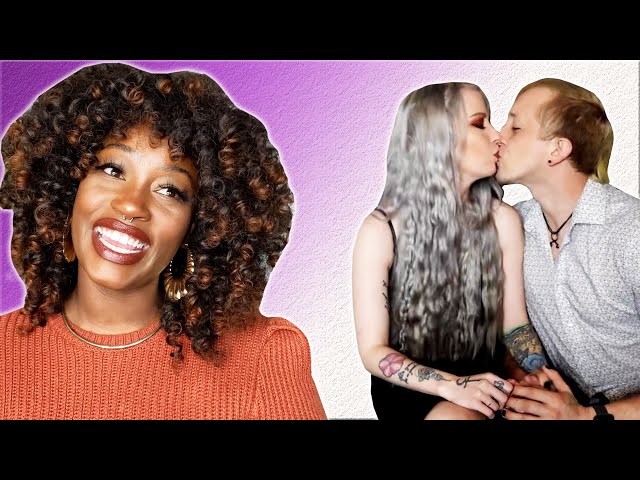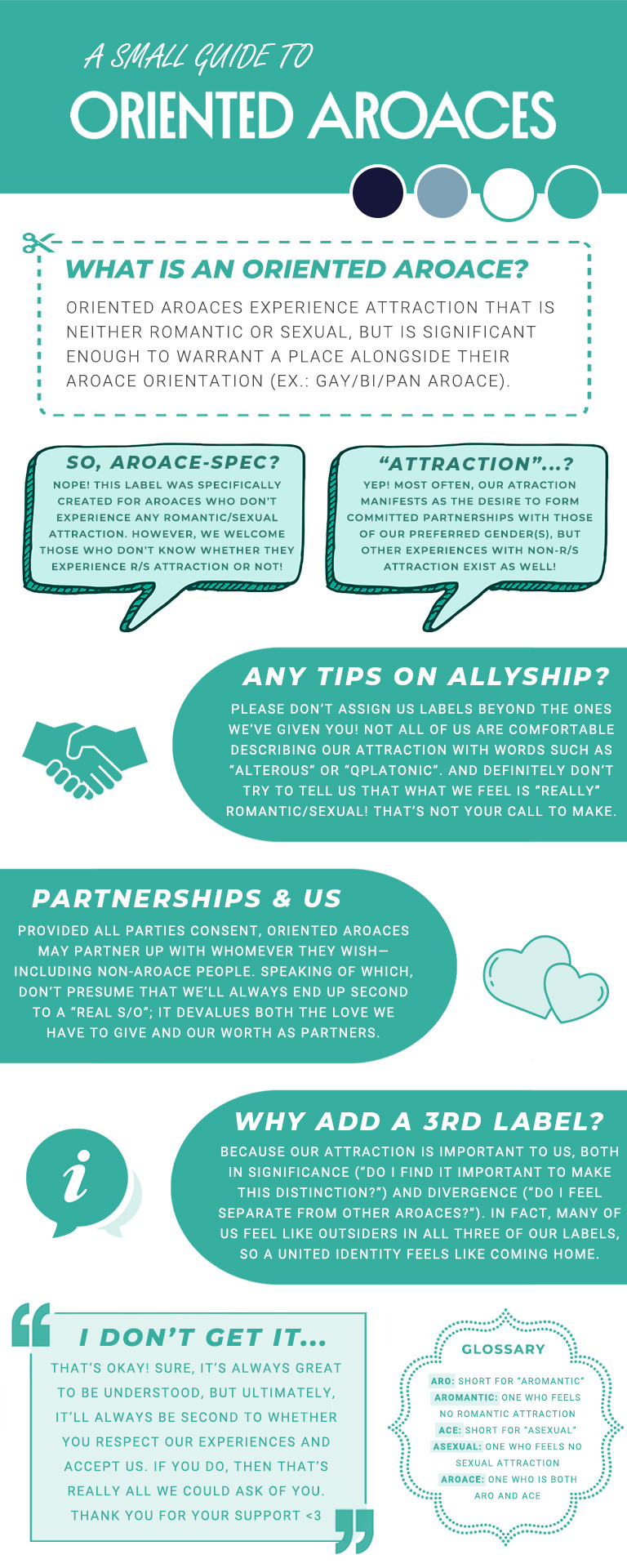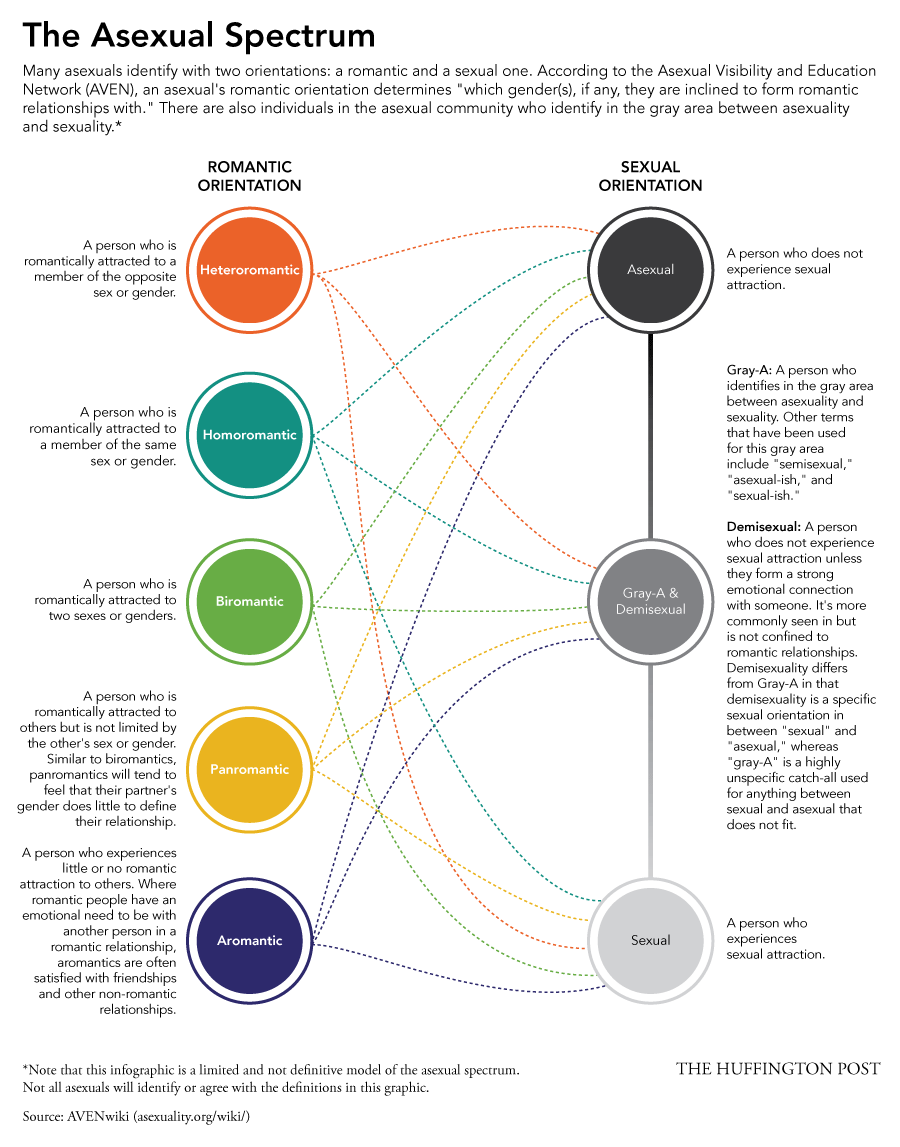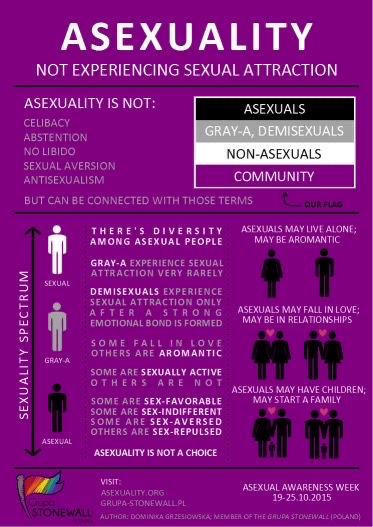Asexual and Aromantic people make up about 1% of the total population but comprise as high as 4% of those ages 18-24 (Bianchi, 2018). This group is relatively small but growing as knowledge of the identity spreads. This page aims to educate folks and dispel misconceptions regarding identities that fall under the ace/aro spectrum.
As a shorthand and a way to include many different identities, such as asexual, aromantic, demisexual, grey-ace, and others on the ace-spectrum, the term ace/aro will be used throughout this page. The ace/aro community faces a lot of misinformation that leads to allosexism. Allosexism is the pervasive system of discrimination and exclusion that oppresses asexual people based in the belief that everyone does and should experience sexual attraction. The resources below are ways to educate oneself about the ace/aro population and to find community within it. There are many different ways to be ace/aro, and the community itself is very diverse.
Terms that May Fall Under the Asexual/Aromantic Spectrum
There are many terms related to the ace/aro spectrum. Here are a few definitions that may be helpful. This is not a comprehensive list of all terms that would fall under the ace/aro spectrum. If you have any terms you would like us to add, please reach out to us at rcsgd@ucsb.edu!
Sources:
Myths
Myths on Ace Identities & Experiences
CW: Allosexist Stereotypes and Tropes
Reality: This myth equates asexuality and aromanticism. There are many different ways to be asexual. Some asexual people may want a romantic relationship or experience sexual attraction. Some may not. It depends on each individual. In summary, some asexual folks may also be aromantic, but not all.
Source: Romantic Orientations | The Asexual Visibility and Education Network
Reality: Individuals who have disabilities are often falsely assumed to be asexual. Thus, many individuals with disabilities are unwillingly desexualized. Although some individuals with disabilities may be ace or aro, having a disability (whether mental, physical, or cognitive) does not imply that an individual is on the ace/aro spectrum. While some individuals with disabilities may feel that their sexual orientation is linked to their disability, it is important to remember that disability does not imply asexuality and asexuality does not imply disability.
Source: Asexual Disabled People Exist, But Don't Make Assumptions About Us - Rooted in Rights
Reality: This myth equates aromanticism and not having feelings. Aromantic folks can have healthy, happy relationships. While these relationships may not be romantic, they can be very fulfilling. There are many different types of relationships. Aromantic folks may have friends, partners, queerplatonic relationships, romantic relationships, and chosen family.
Source: AUREA FAQ
Reality: This myth is often portrayed in media representations of ace/aro folks. Ace/aro folks have emotions. They may not experience sexual attraction or romantic love/attraction, or they may experience it differently. Equating them to inanimate objects (such as robots or plants) invalidates and dehumanizes ace/aro folks.
Source: Asexuality: A Brief Introduction
Reality: This myth equates asexuality and celibacy. While some asexuals are celibate and choose not to have sex, others do. Asexuals can be sex-favorable, sex-indifferent, or sex-repulsed. They may choose to have sex, only have sex in specific circumstances, or never have sex. Some ace/aro folks may feel pressured by partners or by society to engage in sexual activity. However, consent is always necessary and an individual’s orientation towards sex should be respected. Regardless of their decision to have sex or abstain from it, asexuals are valid in their identity.
Reality: Asexuality is completely normal! Asexuality is not a disorder, it is a sexual orientation. It does not need to be fixed or cured by a medical professional. By labeling asexuality as a disorder or a problem, individuals on the ace/aro spectrum may feel stress or alienation.
Source: The Invisible Orientation
Reality: Aromantic folks can experience many different types of love. They may experience platonic love, familial love, queerplatonic love, and more! Some may also experience romantic love, in certain circumstances. The aromantic spectrum is very diverse. It can extend from individuals who do not experience love to those who only sometimes experience love. Regardless, all aromantic folks are valid in their identities.
Source: AUREA FAQ
Reality: This myth invalidates ace/aro folks as a part of the LGBTQIA+ community. The “A” in LGBTQIA+ stands for “Asexual,” “Aromantic” and “Agender.” Ace/aro folks may work closely with the LGBTQIA+ community, and some feel marginalized based on their sexual orientation. Ace/aro folks have the agency to identify or not identify with the LGBTQIA+ community, but those who want to be are included. It is important to note that not all ace/aro folks identify with the LGBTQIA+ community, and many identify as “straight” or “heterosexual.”
Source: General FAQ | The Asexual Visibility and Education Network
Sexualization
Content Warning: Sexualization, racism, medical racism, medical abuse
A variety of factors contribute to certain people’s bodies “being inherently sexualized or desexualized” (Paramo, 2022). Ace/aro folks’ bodies are not excluded from this.
Some ace/aro folks are sexualized due to their race and/or gender. Women (and femme presenting individuals) are often sexualized. Their bodies are deemed attractive and are, therefore, objectified. This issue particularly affects women of color and Black women through the experience of misogynoir and transmisogynoir (Owen, 2014).
Sarah Baartman was born in South Africa in the late 1700s (“Hottentot Venus,” 2022). She was enslaved and forced to perform in exhibitions that consisted of people leering at and touching her nude body (“Hottentot Venus,” 2022). This “Hottentot Venus” show was created, in part, because of white Europeans’ fascination with Black African bodies (“Hottentot Venus,” 2022). It hypersexualized, objectified, and dehumanized Sarah Baartman, and the many other Hottentots forced into the role. This objectification continued after Sarah’s death. Her body was violated and put on display in a museum (“Hottentot Venus,” 2022). These were not taken down until 2002, when South Africa demanded her remains (“Hottentot Venus,” 2022). The treatment of Sarah Baartman during her life (and her death) was appalling (“Hottentot Venus,” 2022). It provides a greater context into today’s world, where Black women are still objectified, dehumanized, and compared to animals (Anderson 2018). Sarah Baartman is a name that must not be erased from history and that provides an illustrative example of the history surrounding the hypersexualization Black women.
This specifically affects Black folks, as shown above in their hypersexualization (“Hottentot Venus,” 2022). As a result, ace/aro folks are often invalidated or not believed in their identity as ace/aro. People claim that they do not “look asexual” or that they are “too sexual to be asexual” (Song 2022). These were claims that asexual lingerie model, Yasmin Benoit, heard quite often. Her identity as a Black woman and an asexual was seen as a contradiction (Song 2022). These false beliefs are examples of acephobia. There is no certain way to look or behave as an ace/aro individual. Asexuality and aromaticism exist on a spectrum, and all individuals that identify on this spectrum are valid. Ace/aro folks must deal with the perceptions and expectations of sex from other individuals. This can be an incredibly distressing experience, possibly having negative effects on people’s mental health.
There is a misconception that ace/aro folks do not have sex, are celibate, or are virgins (Paramo, 2022). Additionally, individuals with disabilities or with an advanced age are often assumed to be asexual (Paramo, 2022). As a result, they meet less resistance when they come out as ace/aro. While this may seem beneficial, individuals on the ace/aro spectrum who also have disabilities or an advanced age may be invalidated and meet resistance when they communicate that they participate in sexual activity (Paramo, 2022). This may be from folks within and outside of the ace/aro community (Paramo, 2022).
Folks are sexualized or desexualized due to different factors, such as gender, race, age, ability, and identity as ace/aro. This sexualization (or desexualization) causes discomfort for those in the community.
- Anderson, Holland, E., Heldreth, C., & Johnson, S. P. (2018). Revisiting the Jezebel
- Stereotype: The Impact of Target Race on Sexual Objectification. Psychology of Women Quarterly, 42(4), 461–476. https://doi.org/10.1177/0361684318791543
- Asexuals and attitudes towards sex. Asexuals and Attitudes Towards Sex | The Asexual
- Visibility and Education Network. (n.d.). Retrieved April 21, 2022,
from https://www.asexuality.org/?q=attitudes.html
- Visibility and Education Network. (n.d.). Retrieved April 21, 2022,
- "Hottentot Venus ." Encyclopedia of Race and Racism. Retrieved
- Merriam-Webster. (n.d.). Desexualize definition & meaning. Merriam-Webster.
- Owen. (2014). On the racialization of asexuality. In Asexualities: Feminist and Queer
- Perspectives (pp. 119–136). https://doi.org/10.4324/9781315882673
- Paramo, M. (2022). Considering intersectionality and (de)sexualizing asexual bodies.
- Song, S. (2022). Meet the activist debunking asexuality stereotypes. PAPER.
Special Dates
Looking for the perfect time to celebrate ace/aro identities? Here are the days designated just for that!
Aromantic Spectrum Awareness Week takes place the first full week after February 14.
International Asexuality Day takes place on April 6 every year!
Asexual Awareness Week takes place the last full week of October. Check out this website to find the dates for this week and get more information.
Videos
Below are a variety of videos that seek to educate folks on ace/aro people and their experiences. Some are documentaries that seek a wide range of information, while others are casual videos and informal vlogs.
If you have suggestions for videos to add to the list, submit them to rcsgd@sa.ucsb.edu!

Jasmine Benoit Youtube Channel
Yasmin Benoit is a Black, British alternative model and asexuality activist. She talks about her experience as a lingerie model, her experiences of asexuality, and the need for more representation.
Resources/Citations
Below are a variety of resources that seek to educate folks on ace/aro people and their experiences. If you have suggestions for resources to add to the list, submit them to rcsgd@sa.ucsb.edu!
This GroupMe Chat is open to all especially those that are Asexual, Aromantic, Demisexual, Grey-Ace, Ace-Spectrum, or questioning people at UCSB who are seeking community! Please feel free to chat, rant, organize, and gather here. This will also serve as a space to help us plan more ace-specific programming! Click the link above to join the GroupMe.
AVEN is a website containing the world's largest online asexual community. It was created by founder David Jay in 2001. Check out this page for information, resources, and community.
AUREA is a volunteer-based initiative that aims to be representatives for the aromantic community. It provides a glossary, resources, and an extensive FAQ.
This Advocates for Youth presentation highlights questions someone can ask when trying to determine if they’re ace/aro. It looks at how to come out, establishing healthy relationship, and what being sexually active looks like.
This Trevor Project article contains definitions, an FAQ, and resources for ace/aro folks.
This Trevor Project document highlights asexuality and examines ace-specific issues. They also list what NOT to say to ace/aro folks.
Asexuality: A Brief Introduction is a compilation of possible signs of asexuality, myth-busting, personal perspectives, and the relation to sex, love, and porn.
Vesper H. (Queer as Cat on Youtube) compiles a list of resources for Asexual POCs, including stories, art, articles, and videos.
Notes of an Asexual Muslim is a collection of posts by or about asexuals and asexuality and provides resources for those who are Muslim.
Attraction comes in many different forms. This Healthline article outlines some of the types of attraction and related terms.
The LGBT Center at UNC-Chapel Hill defines terms relating to asexuality, types of attraction, and types of romantic orientation.
The Demisexuality Resource Center provides resources for demisexuals, partners, and allies. It features articles and translations of them in different languages.
The Invisible Orientation is a book explaining asexuality, explaining what asexuality is not, and why asexuality does not have to be “cured.”
AZE is an independent online journal publishing ace, aro, and agender writers and artists. It was established in 2016 and has more than fifteen issues.
Angela Chen writes about compulsory heterosexuality, what it means to be asexual in a world that’s obsessed with sexual attraction, and what the ace perspective can teach all of us about desire and identity.
Gender Discrepancy in Asexual Identity explores the gender distribution in asexual people. According to their research, the majority of people who identify as asexual are women. It researches why this gender discrepancy exists, and how it relates to gender norms.
The Coming Out Handbook gives an overview of what coming out is, what it looks like, and how to feel safe and supported throughout the coming out process. *This resource is not specifically designed for ace/aro individuals, but can still be helpful!*
Stonewall outlines how to be an ally to asexual people. The first is believing them. This article may be helpful to learn more ways to be an ally to the ace/aro community. This article could be useful to share when coming out as asexual.
This them. article considers the popular series, Bojack Horseman, and its storyline following an asexual character, Todd, and his experiences dating. The article appreciates the relatable components of the characters Todd and Yolanda, and praises the scenes about their coming out process, and examines their relationship.
Asexual Groups is a list of the asexual groups worldwide! Check out this site to find local groups (such as LA and SoCal).
This is a dynamic list of aro/ace youtubers and is constantly evolving. Watch their content to support aro/ace creators.
Infographics
Source: A Small Guide to Oriented Aro Aces

Source: The Asexual Spectrum

Source: Asexuality: Not experiencing sexual attraction
